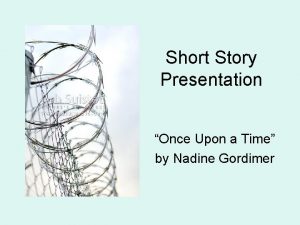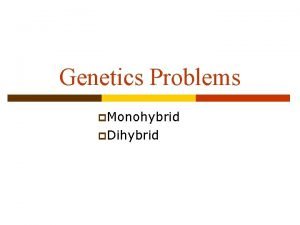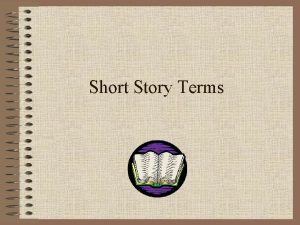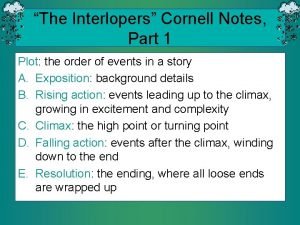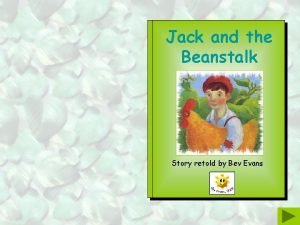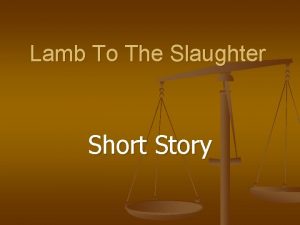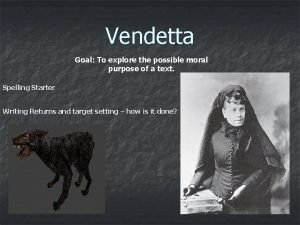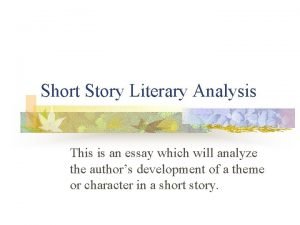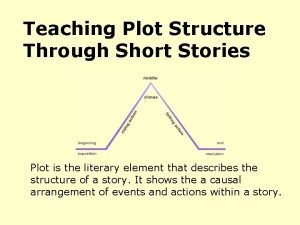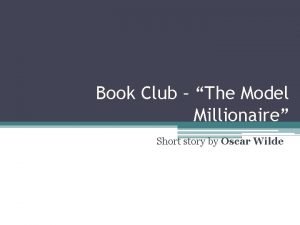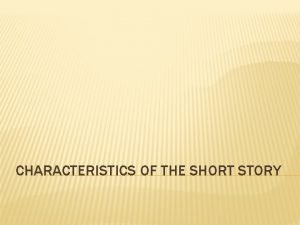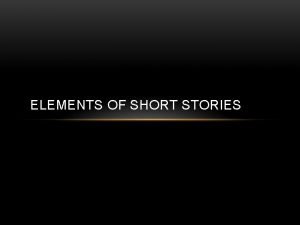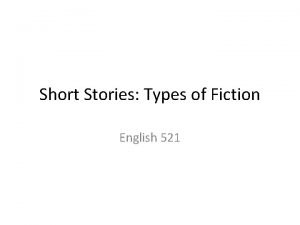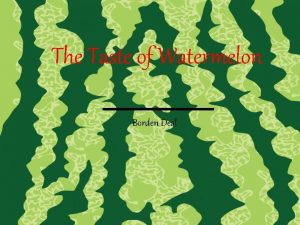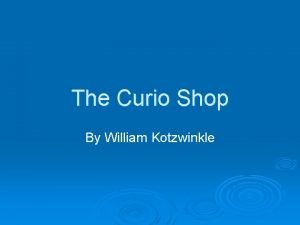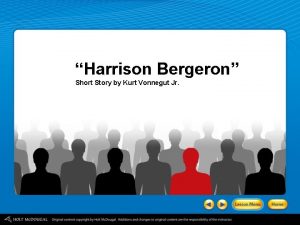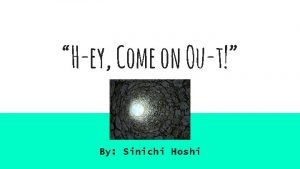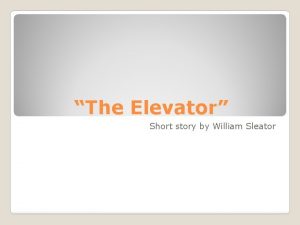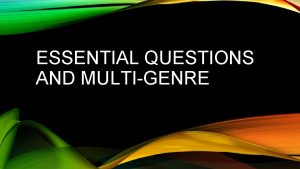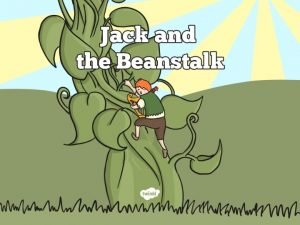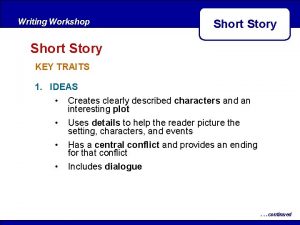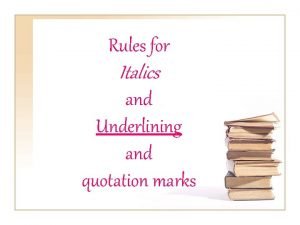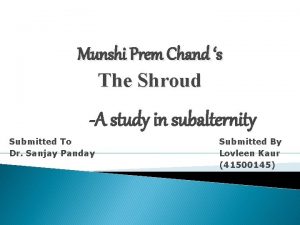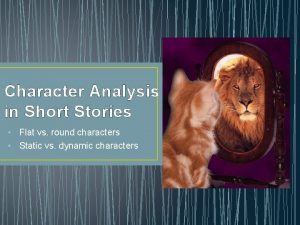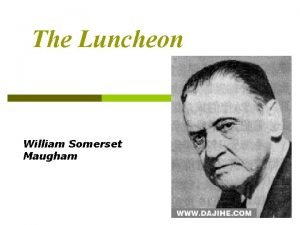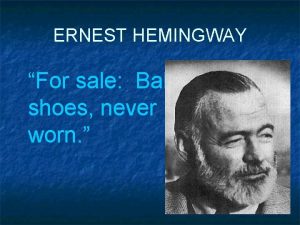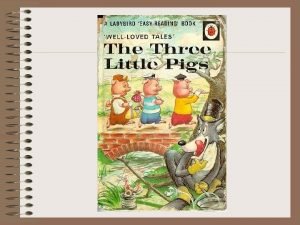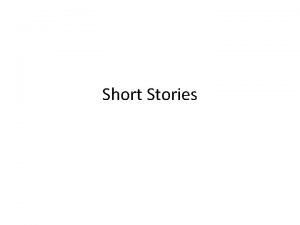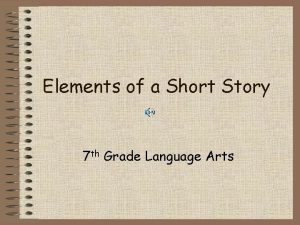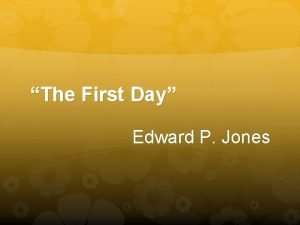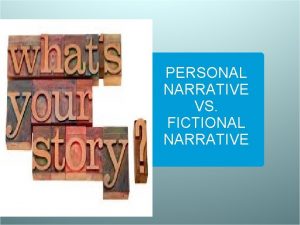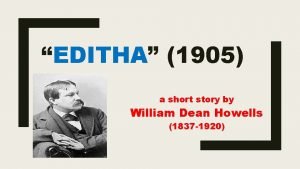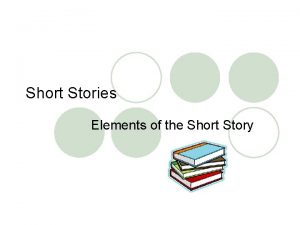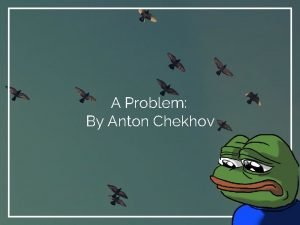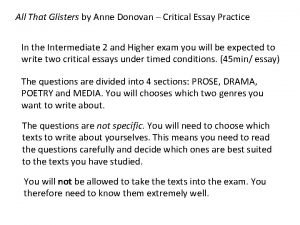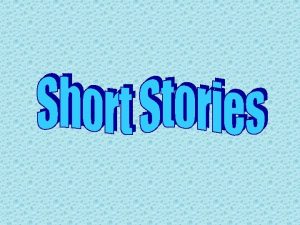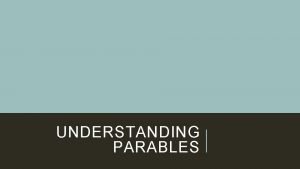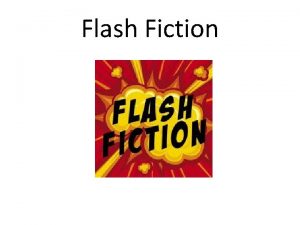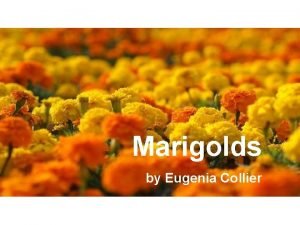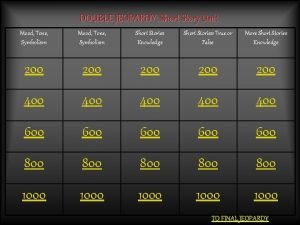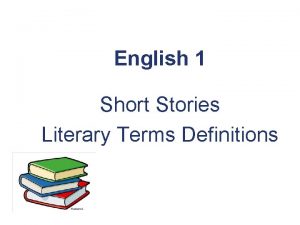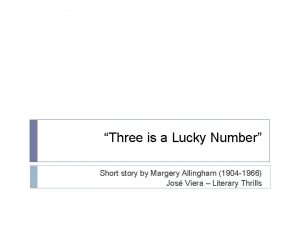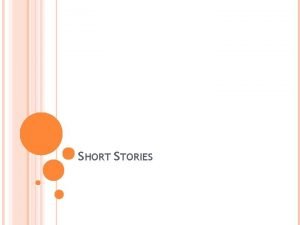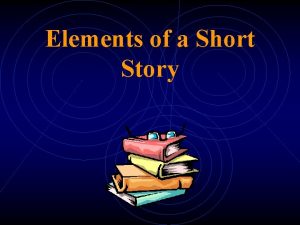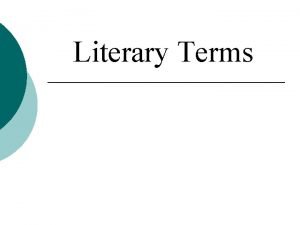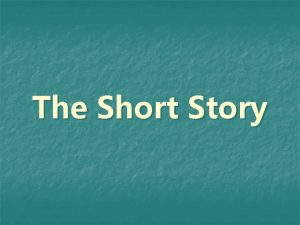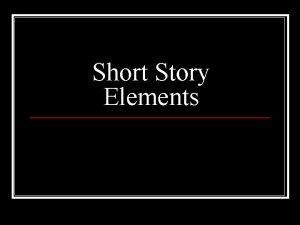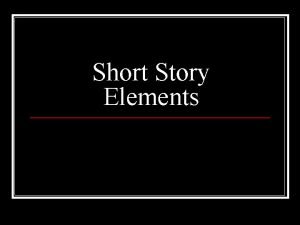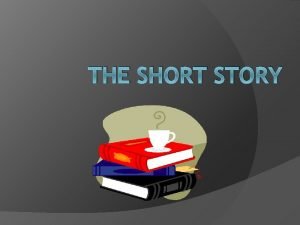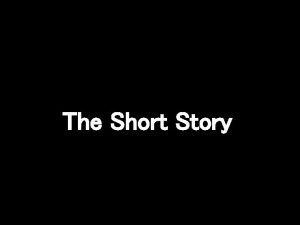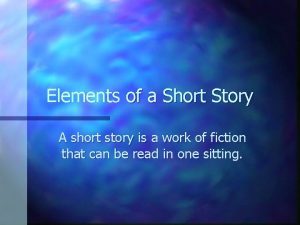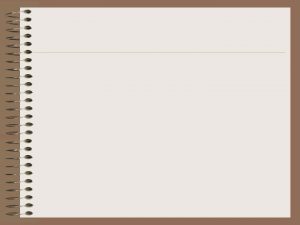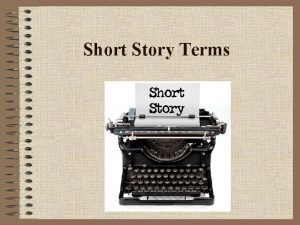What is a Short Story A short story

















































- Slides: 49



What is a Short Story? • A short story is a short narrative that is written to entertain and sometimes bring a message (theme) to the reader. • All stories are based on a struggle (conflict) the author tries to resolve (climax). • By its nature, short stories are concise and focus on a few elements (character, conflict, description, setting, plot).

Characteristics of a Short Story A short story contains only one major character, plot, setting, and theme. A short story usually focuses on a single conflict, character or emotional effect.

There are four kinds of short story, identified by emphasis on one of the following: 1) Action 2) Character 3) Atmosphere/Mood 4) Theme

A good short story, besides being brief and imaginative, has its incidents deliberately selected, often purposely leaving gaps to create questions in the reader’s mind. • It is compressed, which gives the effect of restrained power. • It has a simple plot skillfully spun and often centered around a trivial incident. • It contains suspense, developing a curiosity and tension regarding the outcome. • Its movement is swift and direct towards the climax which marks the highest point of interest. • Frequently, foreshadowing or hints are deliberately dropped by the writer to give promise of things to come.

One also finds immediacy, or that quality in a short story which makes the reader feel he is really living the part, not merely reading about it.

Parts of the Short Story

Introduction • The beginning of the story. • Its main purpose is to make the reader continue reading through the use of suspense, violence, excitement, action, or by something unusual. • Often answers the questions: Ø Where is this place? ØWhat has happened up to now? Ø Who are these people? Ø When does the story take place? Ø What will happen next? • By answering these questions, the introduction establishes the setting and introduces the main characters.

Setting • The time and location in which a story takes place. For some stories the setting is very important, while for others it is not.

There are several aspects of a story’s setting to consider when examining how setting contributes to a story (some, or all may be present in a story). a) Place - geographical location. Where is the action of the story taking place? b) Time – When is the story taking place? (historical period, time of day, year, etc). c) Weather conditions – Is it rainy, sunny, stormy, etc? d) Social conditions – What is the daily life of the character like? Does the story contain local colour (speech, dress, customs, of a particular place)? e) Mood or Atmosphere – What feeling is created at the beginning of the story? Is it bright and cheerful or dark and frightening?

What is the Plot? • How the author arranges events to develop his basic idea; It is the sequence of events in a story or play. • The plot is a planned, logical series of events having a beginning, middle, and end. • The short story usually has one plot so it can be read in one sitting. There are five essential parts of plot

1) Exposition or Introduction • The beginning of the story where the setting and characters are introduced Exposition

2) Rising Action Risin g Ac tion • This is where the events in the story become complicated and the conflict in the story is revealed (events between the introduction and climax).

3) Climax • This is the highest point of interest and the turning point of the story. The reader wonders what will happen next; will the conflict be resolved or not? Climax

4) Falling Action • The events and complications begin to resolve themselves. The reader knows what has happened next and if the conflict was resolved or not (events between climax and resolution) ing Fall on Acti

5) Resolution or Denouement • This is the final outcome or untangling of events in the story. The conflict is completely wrapped up and the story ends. Resolution

Character There are two meanings for the word Character: 1) The person in a work of fiction. 2) The characteristics of a person.

Character • Character – a person in a story, poem or play. • Types of Characters: – Round- fully developed, has many different character traits – Flat- stereotyped, one-dimensional, few traits – Static – Does not change – Dynamic – Changes as a result of the story's events

Characterization • How the author develops the characters, especially the main character. • This is done through: – the characters physical appearance – what the character does or does not do – what the character says, thinks, feels, dreams – what others say about the character and how they react to him – author’s word choice in descriptive passages

Characterization • Direct characterization – The author directly states what the character’s personality is like. Example: cruel, kind • Indirect characterization – Showing a character’s personality through his/her actions, thoughts, feelings, words, appearance or other character’s observations or reactions

Protagonist and Antagonist Short stories use few characters. One character is clearly central to the story with all major events having some importance to this character – he/she is the Protagonist. The opposition to the main character is called the Antagonist.

Protagonist • Main character of the story who changes – (death is not a change) – the most important character – changes and grows because of experiences in the story

Antagonist • A major character who opposes the protagonist – the antagonist does not change • Types of antagonists: – people – nature – society

• Conflict is essential to plot. Without conflict there is no plot. It is the opposition of forces which ties one incident to another and makes the plot move. • Conflict is not limited to open arguments, rather it is any form of opposition that faces the main character. • Within a short story there may be only one central struggle, or there may be one dominant struggle with many minor ones.

Conflict • A struggle between two opposing forces • Types: – Internal – takes place in a character’s own mind • Man vs. Him(Her)self (psychological) – External – a character struggles against an outside force • • • Man vs. Man (physical) Man vs. Nature Man vs. Technology/Progress Man vs. Society (social) Man vs. Supernatural

A conflict between the forces of good, represented by the hero (protagonist) and the forces of evil, represented by the villain (antagonist) may occur. Out of this conflict may grow a trap or obstacle which the hero must overcome.

Theme • The central message or insight into life revealed through a literary work. • The “main idea” of the story

The theme in a piece of fiction is its controlling idea or its central insight. - It is the author’s underlying meaning or main idea that he is trying to convey. - The theme may be the author’s thoughts about a topic or view of human nature. - The title of the short story usually points to what the writer is saying and he may use various figures of speech to emphasize theme, such as symbol, simile, metaphor, hyperbole, or irony.

Some simple examples of common themes from literature, TV, and film are: • • Things are not always as they appear to be Love is blind Believe in yourself People are afraid of change

Point of View The vantage point or angle from which the writer tells the story. 1) First person- The story is told by the protagonist or one of the characters who interacts closely with the protagonist or other characters. The reader sees the story through this persons eyes as he/she experiences it and only knows what he/she knows or feels. - Use of the pronouns “I”, “me”, “we”.

Point of View 2) Third person - The narrator is someone outside the story, who refers to all the characters by name, or as “he, ” “she, ” “they. ” Centers on one character’s thoughts and actions. 3) Innocent Eye – The story is told through the eyes of a child (his/her judgment being different from that of an adult). 4) Stream of Consciousness – The story is told so that the reader feels as if they are inside the head of one character and knows all their thoughts and reactions.

Point of View 5) Omniscient- All knowing narrator. The author can center on the thoughts and actions of any and all characters. He can move from character to character, event to event, having free access to the thoughts, feelings and motivations of his characters and he introduces information where and when he chooses. There are two main types of omniscient point of view:

Two main types of omniscient point of view: a) Omniscient Limited – The author tells the story in third person (using pronouns they, she, it, etc). We know only what the character knows and what the author allows him/her to tell us. We can see thoughts and feelings of characters if the author chooses to reveal them to us. a) Omniscient Objective – The author tells the story in the third person. It appears as though a camera is following the characters, going anywhere, and recording only what is seen and heard. There is no comment on the characters or their thoughts. No interpretations are offered. The reader has to interpret events on his own.

Literary Terms

Flashback The present scene in the story is interrupted to flash backward and tell what happened in an earlier time.

Foreshadowing Refers to clues that hint at what is going to happen later in the plot. It is used to arouse the reader’s curiosity, build suspense, and help prepare the reader to accept events that occur later in the story.

Symbol An object, person, or event that functions as itself, but also stands for something more than itself. Example: Scales function is to weigh things, but they are also a symbol of our justice system.

Figurative Language • Involves some imaginative comparison between two unlike things. – Simile – comparing two unlike things using like or as. • “I wandered lonely as a cloud” – Metaphor – comparing two unlike things (not using like or as) • Life is a roller coaster, it has lots of ups and downs.

Figurative Language • Personification – Giving human qualities to non-human things. – “The wind howled”

Irony • A literary device that creates a contrast or discrepancy between expectation and reality; between what is said and what is meant.

Irony • Verbal Irony – saying one thing but meaning something completely different. – Calling a clumsy basketball player “Michael Jordan” • Situational Irony – A contradiction between what we expect to happen and what really does happen • Dramatic Irony – occurs when the reader knows something important that the characters in the story do not know.

Allusion • Reference to a statement, person, a place, or events from: – Literature – History – Religion – Mythology – Politics – Sports

Suspense A feeling of tension, anxiety, or excitement resulting from uncertainty. An author creates suspense to keep the reader interested.

Atmosphere (Mood) • The prevailing feeling in a literary work created by word choice, descriptive details and evocative imagery.

Imagery • Creating a picture in the readers mind through description • Language that appeals to the senses. – Touch – Taste – Sight – Sound – Smell

Gothic Fiction Originally referred to the middle ages but now extends to a type of fiction which lacks the medieval setting, but develops a brooding atmosphere of gloom and terror, represents events which are uncanny or macabre or melodramatically violent and often deals with aberrant psychological states. Gothic Fiction distinguishes itself through the narrative technique of using suspense and the development of atmosphere to enhance the plot thereby capturing reader interest.

Poetic Justice is a literary device in which virtue is ultimately rewarded or vice punished.

 Tall+short h
Tall+short h What is a short story
What is a short story Once upon a time story writing
Once upon a time story writing Heterozygous short-hair x heterozygous short-hair
Heterozygous short-hair x heterozygous short-hair Short story terms
Short story terms The interlopers plot diagram
The interlopers plot diagram Jack and the beanstalk short story
Jack and the beanstalk short story Short story lamb to the slaughter
Short story lamb to the slaughter The widow of paolo saverini
The widow of paolo saverini Literary analysis example for a short story
Literary analysis example for a short story Short story definition
Short story definition The bet plot
The bet plot Beginning climax conclusion
Beginning climax conclusion Theme of cinderella story
Theme of cinderella story The model millionaire story
The model millionaire story Short stories characteristics
Short stories characteristics It is the structure or arrangement of the story
It is the structure or arrangement of the story Point of view
Point of view Maikling kwento
Maikling kwento The taste of melon theme
The taste of melon theme The curio shop by william
The curio shop by william Harrison bergeron drawing
Harrison bergeron drawing Hey come on out plot
Hey come on out plot The elevator summary
The elevator summary Essential questions for short stories
Essential questions for short stories Once upon a time there was a boy story
Once upon a time there was a boy story Short story traits
Short story traits Underline vs quotation marks
Underline vs quotation marks The short story the shroud is written by
The short story the shroud is written by Short story character analysis
Short story character analysis Summary of the luncheon
Summary of the luncheon For sale baby shoes
For sale baby shoes Once upon time there were three little pigs
Once upon time there were three little pigs Short story the birthmark
Short story the birthmark 7 elements of a short story
7 elements of a short story The first day by edward p jones analysis
The first day by edward p jones analysis What is a fictional narrative
What is a fictional narrative Editha short story
Editha short story Dramatic irony in the sniper
Dramatic irony in the sniper Elements of short stories vocabulary
Elements of short stories vocabulary Sasha uskov
Sasha uskov Hieroglyphics anne donovan text
Hieroglyphics anne donovan text Characters setting plot
Characters setting plot Short sotry
Short sotry Short parables
Short parables Fiction
Fiction Marigolds by eugenia collier
Marigolds by eugenia collier Jeopardy tone
Jeopardy tone Short story literary definition
Short story literary definition Three is a lucky number summary
Three is a lucky number summary


